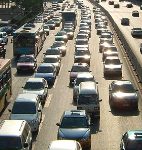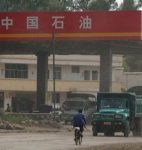A small green bud sprouted in China’s statistical forest when a report that summarised the country’s first effort at “green accounting” was published in September 2006. The report was the result of two years’ work by China’s National Bureau of Statistics (NBS) and the State Environmental Protection Administration (SEPA). It had backing from senior leaders who increasingly talk of “sustainable development”, a concept that many environmentalists understand as economic growth that does not damage the value of nature’s assets.
There were three headline conclusions to the NBS-SEPA report. Firstly, China emitted 511.8 billion yuan (US$64 billion) worth of pollution in 2004, equivalent to 3.1% of GDP. Secondly, the estimated clean-up cost for this pollution was calculated at 287.4 billion yuan (US$36 billion), 1.8% of GDP –around three times more than the actual money spent (100.5 billion yuan, or US$13 billion). Thirdly, if the country used current technology and today’s standards to solve this pollution at the source, it would need a one-off investment of 1,080 billion (US$135 billion), 6.8% of GDP. China’s 11th Five Year Plan, which began this year, calls for 1.4 trillion yuan (US$175 billion) to be spent on environmental clean up – 280 billion yuan a year, a figure similar to the 2004 clean-up cost. But it still looks like NBS and SEPA are positioning this report as a call for a much larger investment.
The report was an important move, but at 10 pages – at least in the public version – it was only a start.
Economists like to measure gross domestic product (GDP) – goods and services produced – since it is a straightforward concept, it is relatively easy to calculate and is comparable across time and place. But GDP does not capture the cost of using up finite resources and the price of environmental damage, both of which will undermine future GDP growth. Over the last 30 years, economists and environmentalists around the world have attempted to come up with alternative measures or to adjust GDP to correct for this problem. The “holy grail” has been “green GDP”: a single number equal to the value of goods and services minus all the resource depletion and value of environmental damage.
It is not surprising that environmentalists and political leaders want to know their green GDP, and how fast it is growing (or declining). In theory, it allows for the sustainability of development to be easily tracked. The big attraction for China is that if local government officials were evaluated using this metric, it could provide a powerful incentive for them to protect their local environments.
But the experience of places like Norway and the US is that green GDP is near impossible to calculate – and not that useful anyway. Coal is easy to price since people buy it, but how do you price clean air and how do you value a forest that is not being cut down? How do you calculate the damage to underground water, to human health and ecological systems? Such questions seem endless, and green GDP requires all of them to be answered consistently and accurately.
Recognising these limitations, the surveys NBS and SEPA carried out in 2004-05 did not attempt to assess resource depletion or any damage to China’s ecological systems. On the one thing they did measure – pollution emissions – they only tracked 10 of the more than 20 types of pollutant. In short, they only measured the tip of China’s environmental iceberg.
However, not all of the issues raised by green GDP are insurmountable. Economists recommend three ways around them, and China does appear to be adopting all of them. Firstly, China’s environmental statisticians have begun to use “physical flow accounting”: tables which allow one to track pollutants as they move around economies, even across national boundaries. These help with assessments of sustainability in various parts of the economy – and in designing policies that will lead to improvements.
Secondly, China has started to use distinct environmental measures to monitor the environment and provide incentives for local officials. Some countries go in for big measures of development, such as the “Genuine Progress Indicator”: a composite index of a number of economic, social and environmental indicators. But a lot of things get mixed up in such indices, and it is ultimately more useful to break things down.
The 11th Five Year Plan has made a start at this, setting up targets in a number of different areas, such as energy efficiency (reducing energy-use per unit GDP by 20% compared to the 2005 level), and water consumption (reducing per unit industrial output by 30%). It also features targets on air pollutant emissions, water quality and protection of arable land. Data for 2005 and the first half of 2006 suggest that air and water pollution indicators are going the wrong way. Energy efficiency also fell by 0.8 percentage points when it should rise four percentage points over the entire year. Local officials must be sensing that such things are beginning to make a difference to their promotion prospects.
Thirdly, the NBS-SEPA team has appeared to tackle the valuation question head-on. For instance, they value air pollutant emissions in 2004 at 511.8 billion (US$64 billion), equivalent to 3.1% of GDP. This is a useful step – it creates press headlines in which environmental costs come with a price tag that everyone understands, and it should also allow officials to start rationally assessing policy choices with cost-benefit analysis.
Monitoring is one thing, but enforcement of course is another. At present, provincial, municipal and even county SEPA offices are run primarily by local governments. This is a widespread problem in China, where local directors of such bureaus owe their appointments, budgets and promotions to local leaders, and so are always under pressure to side with local interests. When SEPA attempt to investigate, fine or close down polluting facilities, localities often simply ignore them. But now there is some discussion of the system being reorganised to allow SEPA to gain administrative control – with the first step being the recent establishment of five regional offices.
Sadly, however, it may require a serious crisis to trigger the kind of restructuring that would be needed. It would be regrettable, to say the least, if it took a bigger environmental disaster than the 100-tonne benzene spill into the Songhua River in Jilin province in December 2005 to encourage this. Without better enforcement, it is difficult to be optimistic about slowing the pace of depreciation in China’s natural environment – and it will be doubly painful if we can measure it.
Dr. Stephen Green is a senior economist at Standard Chartered Bank in Shanghai.



